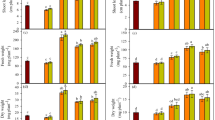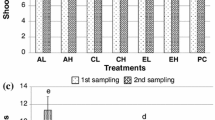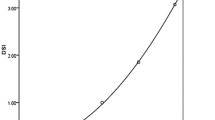Abstract
The effect of pesticides on arbuscular mycorrhizal (AM) fungi and plants are of interest to agriculture. Hence, the present study was conducted to understand the potential effect of two systemic fungicides (Ridomil “250 and 500 mg/L” and Bavistin “500 and 1000 mg/L”) and one insecticide (Agrothoate 40% EC “1.25 and 2.50 ml/L H2O”) on AM fungal colonization, some biochemical changes and K+ content of cucumber plants (Cucumis sativus L.). AM and non-AM cucumber plants were exposed to two concentrations of each pesticide. Results revealed an increase in mycorrhizal colonization (F%) with Ridomil and Bavistin applications however there was a decrease in this percentage with Agrothoate. Stimulation of phosphatase enzymes activity was observed subsequent to pesticides application. Moreover, there was a significant decrease in K+ content with increasing pesticides concentration, and this decrease was more distinct in non-AM cucumber plants than AM ones. Our results also showed a significant increase in malondialdehyde (MDA) content in all pesticides treated cucumber plants relative to control ones. Thus, the content of non-enzymatic antioxidants such as phenolic and flavonoids was stimulated by pesticides application and with AM fungal inoculation, further augmentation in their contents was detected. Therefore AM fungi can partially or completely alleviate pesticides toxicity and helpful to overcome some of their negative effects on the biochemical metabolites of cucumber. Thus the judicious use of these pesticides may have stimulatory effect on AM fungal colonization.




Similar content being viewed by others
Abbreviations
- Agr:
-
agrothoate
- AM:
-
arbuscular mycorrhizal
- Ba:
-
bavistin
- DW:
-
dry weight
- FW:
-
fresh weight
- MDA:
-
malondialdehyde
- Ri:
-
ridomil
- ROS:
-
reactive oxygen species
References
Abdel-Fattah GM, Asrar AWA (2012) Arbuscular mycorrhizal fungal application to improve growth and tolerance of wheat (Triticum aestivum L.) plants grown in saline soil. Acta Physiol Plant 34:267–277
Abdel-Fattah GM, Rabie GH, Lamis DSh, Metwally RA (2016) The impact of arbuscular mycorrhizal fungi on growth and physiological parameters of cowpea plants grown under salt stress conditions. Int J Appl Sci Biotechnol 4:372–379
Abdelhameed RE, Metwalley RA (2018) Mitigation of salt stress by dual application of arbuscular mycorrhizal fungi and salicylic acid. Agrochimica 62(4) (in press).
Abdelhameed RE, Metwally RA (2019) Alleviation of cadmium stress by arbuscular mycorrhizal symbiosis. Int J Phytoremediation. https://doi.org/10.1080/15226514.2018.1556584.
Ahmed S, Siddiqui ZS (1995) Effect of topsin-M (methyl-thiophenate) fungicide on chlorophyll, protein and phenolic contents of Hibiscus esculentus and Capsicum annuum. Pak J Bot 27:175–178
Aktar W, Sengupta D, Chowdhury A (2009) Impact of pesticides use in agriculture: their benefits and hazards. Interdiscip Toxicol 2(1):1–12
Al-Garni SM (2005) Influence of Rizolex-T-60 WP and Furadan- 10G on Glomus clarum colonization and growth of watermelon. Bull Pure Appl Sci 24B(2):103–112
Bary F, Gange AC, Crane M, Hagley KJ (2005) Fungicide levels and arbuscular mycorrhizal fungi in golf putting greens. J Appl Ecol 42(1):171–180
Bradford MM (1976) A rapid and sensitive method for the quantification of microgram quantities of protein utilizing the principle of protein-dye binding. Annu Rev Biochem 72:248–254
Chapman HD, Pratt P (1982) Methods of analysis for soils, plants and water, priced publication, vol. 4034. University of California, Division of Agricultural Sciences, Berkeley
Dias MC, Figueiredo P, Duarte IF, Gil AM, Santos C (2014) Different responses of young and expanded lettuce leaves to fungicide Mancozeb: chlorophyll fluorescence, lipid peroxidation, pigments and proline content. Photosynthetica 52(1):148–151
Dubois M, Gilles KA, Hamilton JK, Rebers PA, Smith F (1956) Calorimetric method for determination of sugars and related substances. Anal Chem 28:350–356
Gaschler MM, Stockwell BR (2017) Lipid peroxidation in cell death. Biochem Biophys Res Commun 482:419–425
Gerdemann JW, Nicolson TH (1963) Spores of mycorrhizal Endogone species extracted from soil by wet sieving and decanting. Trans Br Mycol Soc 46:235–244
Groth DE, Martinson CA (1983) Increased endomycorrhizal infection of maize and soybeans after soil treatment with metalaxyl. Plant Dis 67:1377–1378
Hage-Ahmed K, Rosner K, Steinkellner S (2018) Arbuscular mycorrhizal fungi and their response to pesticides. Pest Manag Sci 75(3):583–590
Huang He, Xiong ZT (2009) Toxic effects of cadmium, acetochlor and bensulfuron-methyl on nitrogen metabolism and plant growth in rice seedlings. Pestic Biochem Physiol 94:64–67
Ipsilantis I, Samourelis C, Karpouzas DG (2012) The impact of biological pesticides on arbuscular mycorrhizal fungi. Soil Biol Biochem 45:147–155
Jackson ML (1967) Soil chemical analysis. Prentice-Hall of India Private Limited, New Delhi
Jaleel CA, Gopi R, Panneerselvam R (2007) Alterations in lipid peroxidation, electrolyte leakage, and proline metabolism in Catharanthus roseus under treatment with triadimefon, a systemic fungicide. C R Biol 330:905–912
Jaya Madhuri R, Rangaswamy V (2015) Effect of three selected fungicides on soil dehydrogenase, phosphatase, protease and urease enzyme activities in groundnut (Arachis hypogeae L.) fields. Int J Innov Sci Eng Technol 2(10):677–697
Jin H, Germida J, Walley F (2013) Suppressive effects of seed-applied fungicides on arbuscular mycorrhizal fungi (AMF) differ with fungicide mode of action and AMF species. Appl Soil Ecol 72:22–30
Jindal KK, Singh RN (1975) Phenolic content in male and female Carica papaya: a possible physiological marker sex identification of vegetative seedlings. Physiol Plant 33(1):104–107
Kapoor R, Evelin H, Mathur P, Giri B (2013) Arbuscular mycorrhiza: approaches for abiotic stress tolerance in crop plants for sustainable agriculture. In: Tuteja N, Gill SS (eds.) Plant acclimation to environmental stress. Springer Science? Business Media, LLC, Dordrecht, pp. 359–401
Kengar YD, Patil BJ, Sabale AB (2014) Effect of hexaconazole and triazophos on carbohydrate contents in germinating seeds of Spinach and Guar. Central European. J Exp Biol 3(3):16–21
Kumar A, Tewari R, Shukla A (2005) Effect of some fungicides on development of vesicular arbuscular mycorrhizae and growth of Sesbania sesban. Indian J Agrofor 7(2):55–57
Li J, Ou-Lee TM, Raba R, Amundson RG, Last RL (1993) Arabidopsis flavonoid mutants are hypersensitive to UV-B radiation. Plant Cell 5:171–179
Macoy MD, Kim WY, Lee YS, Kim GM (2015) Biosynthesis, physiology, and functions of hydroxycinnamic acid amides in plants. Plant Biotechnol Rep 9:269–278
Mallmann GC, Sousa JP, Sundh I, Pieper S, Arena M, da Cruz SP, Klauberg-Filho O (2018) Placing arbuscular mycorrhizal fungi on the risk assessment test battery of plant protection products (PPPs). Ecotoxicology. https://doi.org/10.1007/s10646-018-1946-0
Metwally RA, Abdelhameed RE (2018) Synergistic effect of arbuscular mycorrhizal fungi in growth and physiology of salt-stressed Trigonella foenum-graecum plants. Biocatal Agric Biotechnol 16:538–544
Mishra V, Mishra P, Srivastava G, Prasad SM (2011) Effect of dimethoate and UV-B irradiation on the response of antioxidant defense systems in cowpea (Vigna unguiculata L.) seedlings. Pest Biochem Physiol 100:118–123
Mitra J, Raghu K (1998) Pesticides-non target plants interactions: an overview. Arch Agron Soil Sci 43(6):445–500
Mohamed HI, Akladious SA (2017) Changes in antioxidants potential, secondary metabolites and plant hormones induced by different fungicides treatment in cotton plants. Pest Biochem Physiol 142:117–122
Monkiedje A, Ilori MO, Spiteller M (2002) Soil quality changes resulting from the application of the fungicides mefenoxam and metalaxyl to a sandy loam soil. Soil Biol Biochem 34:1939–1948
Murphy J, Riley J (1962) A modified single solution method for the determination of phosphate in natural waters. Anal Chim Acta 27:31–36
Nation JL, Robinson FA (1971) Concentration of some major and trace elements in honeybee, royal jelly and pollen determined by atomic absorption spectrophotometer. J Apicult Res 10:35–43
Nemec S (1980) Effects of 11 fungicides on endomycorrhizal development in sour orange. Can J Bot 58:522–526
Ohkawa H, Ohishi N, Yagi Y (1979) Assay of lipid peroxides in animal tissue by thiobarbituric acid reaction. Anal Biochem 95:351–358
Parween T, Jan S, Mahmooduzzafar FT (2012) Evaluation of oxidative stress in Vigna radiata L. in response to chlorpyrifos. Int J Environ Sci Technol 9:605–612
Piper CS (1950) Soil and plant analysis. International Science Publishers Inc., New York, NY
Rahmansyah M, Antonius S, Sulistinah N (2009) Phosphatase and urease instability caused by pesticides in soil improved by groundnut straw. ARPN J Agric Biol Sci 4(2):56–62
Reddy NS, Dash S, Sontakke (1997) Effect of spraying selected pesticides on the contents of specified minerals in cabbage. Plant Foods Hum Nutr 51(4):357–363
Sanjukta D, Ghosh S (2012) In vitro effect on the antioxidative properties of crude extract of Chenopodium album in presence of the organophosphate, acephate. Int Food Res J 19:1033–1039
Shakir SK, Irfan S, Akhtar B, Rehman S, Daud MK, Taimur N, Azizullah A (2018) Pesticide-induced oxidative stress and antioxidant responses in tomato (Solanum lycopersicum) seedlings. Ecotoxicology 27:919–935
Shakir SK, Kanwal M, Murad W, Rehman Z, Rehman S, Daud MK, Azizullah A (2015) Effect of some commonly used pesticides on seed germination, biomass production and photosynthetic pigments in tomato (Lycopersicon esculentum). Ecotoxicology https://doi.org/10.1007/s10646-015-1591-9
Siddiqui ZS, Ahmed S (2002) Effects of systemic fungicides on protein, carbohydrate, amino acids and phenolic contents of susceptible (Mexipak) and resistant (Povan) varieties of Triticum aestivum L. Turk J Bot 26:127–130
Siddiqui ZS, Ahmed S (2006) Combined effects of pesticide on growth and nutritive composition of soybean plants. Pak J Bot 38(3):721–733
Sreenivasa MN, Bagyaraj DJ (1989) Use of pesticides for mass production of vesicular-arbuscular mycorrhizal inoculum. Plant Soil 119(1):127–132
Srivastava D, Kapoor R, Srivastava SK, Mukerji KG (1996) Vesicular arbuscular mycorrhiza: an overview. In: Mukerji KG (Ed.) Concepts in mycorrhizal research. Springer, Dordrecht, Netherlands, p. 1–39
Suri KS, Singh G (2011) Insecticide induced resurgence of the whitebacked plant-hopper Sogatella furcifera (Horvath) (Hemiptera: Delphacidae) on rice varieties with different levels of resistance. Crop Prot 30:118–124
Tanwar A, Aggarwal A, Kadian N, Gupta A (2013) Arbuscular mycorrhizal inoculation and super phosphate application influence plant growth and yield of Capsicum annum. J Soil Sci Plant Nutr 13(1):55–66
Thakur KK, Sharma DP (2018) Pot-culture studies on soil and leaf nutrients status of peach in response to different soil management techniques for preventing replant disease. J Pharm Innov 7:1046–1053
Trouvelot A, Kough J, Gianinazzi-Pearson V (1986) Measure des taux de mycorhization VA d, UN system radiculaire. Recherche de methoded, estimationayantune signification fonctionnelle. In: Gianinazzi-Pearson V. & Gianinazzi, S (eds.), Physiological and Genetical Aspects of Mycorrhizae, Institut National de la Recherche Agronomique. Press, Paris, p. 217–221
Veeraswamy J, Padmavathi T, Venkateswarlu K (1993) Effect of selected insecticides on plant growth and mycorrhizal development in sorghum. Agric Ecosyst Environ 43(3–4):337–343
Wildon CE, Hammer CL, Bass ST (1957) The effect of 2, 4-D dichlorophenoxy-acetic acid on the accumulation of mineral elements in tobacco plants. Plant Physiol 32:243–244
Yadav A, Aggarwal A (2014) Effect of benomyl and dithane M-45 on mycoflora, mycorrhizae and growth enhancement of Helianthus annuus L. N Y Sci J 7(11):7–15
Zou Y, Lu Y, Wei D (2004) Antioxidant activity of flavonoid-rich extract of Hypericum perforatum L in vitro. J Agric Food Chem 52(16):5032–5039
Author information
Authors and Affiliations
Corresponding author
Ethics declarations
Conflict of interest
The authors declare that they have no conflict of interest.
Additional information
Publisher’s note: Springer Nature remains neutral with regard to jurisdictional claims in published maps and institutional affiliations.
Supplementary Information
Rights and permissions
About this article
Cite this article
Rabab, A.M., Reda, E.A. Impact of Ridomil, Bavistin and Agrothoate on arbuscular mycorrhizal fungal colonization, biochemical changes and potassium content of cucumber plants. Ecotoxicology 28, 487–498 (2019). https://doi.org/10.1007/s10646-019-02042-0
Accepted:
Published:
Issue Date:
DOI: https://doi.org/10.1007/s10646-019-02042-0




